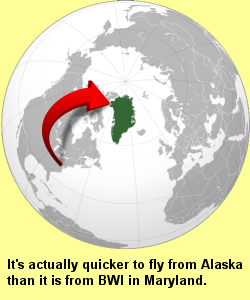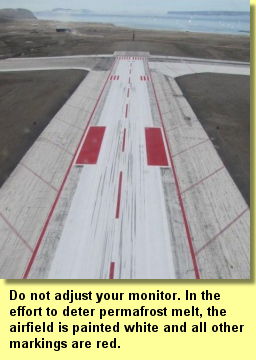 |
 |
Thule Trippin'By Donna SpeidelWe traveled to Thule, Greenland in July. No, it wasn't a vacation; it was an adventure! We escaped 100+ degree temperatures in the Mid-Atlantic area where our office is in exchange for 50-60 degree temperatures 24-hours a day. 750 miles north of the Arctic Circle is where polar bears, icebergs and glaciers live. We learned a lot about glaciers, climate change, permafrost, constant sunlight (while we were there), and met a lot of Danes who work at the air base. I was even introduced to Tuborg, a Danish beer that I learned to like. Then I realized it spelled Grobut backwards, and didn't like it as much!
Planning ahead there is absolutely paramount. To ship materials to paint the runway, for example, one has to order them almost a year in advance so they can be processed and shipped via freighter just after the ocean thaws in May or June. The painting season is short, beginning in June and ending in mid August. And as you might expect, there is a considerable amount of snowplowing that occurs there; but ice is the biggest challenge for airfield maintenance.
We had the benefit of arriving during the summer months when visibility was good and icy conditions were a recent memory, when the mosquitoes were flying around in swarms and dive-bombing anything that exhaled CO2; I had never seen a mosquito cast a shadow until Thule. It was an experience, an adventure, and a challenge we won't forget. |

 The history of the air base is fascinating. Begun in 1951 during the Cold War, it became the northernmost outpost for
reconnaissance. The runway there was built in 104 days/nights, and subsequently hangars, taxiways, and aprons were constructed. But with the
runway in place, transporting supplies to the remote location was suddenly much easier and faster than the month it took 81 ships to go from
Norfolk to Thule with the necessary materials, equipment, food and 5,000 men required to build the runway, lodging, and other buildings to
support the effort.
The history of the air base is fascinating. Begun in 1951 during the Cold War, it became the northernmost outpost for
reconnaissance. The runway there was built in 104 days/nights, and subsequently hangars, taxiways, and aprons were constructed. But with the
runway in place, transporting supplies to the remote location was suddenly much easier and faster than the month it took 81 ships to go from
Norfolk to Thule with the necessary materials, equipment, food and 5,000 men required to build the runway, lodging, and other buildings to
support the effort.
 One of the things that made this airfield unique is that the asphalt surfaces of the runway, taxiways, and aprons are painted
white, and all of the markings are red. The white paint has been applied for many years, theoretically as a deterrent to softening the underlying
permafrost. The downside is the white paint severely diminishes the friction coefficient of the pavement. When planes are coming in during darkness
in the dead of winter, and the pavement is slippery, it must make for an exciting landing.
One of the things that made this airfield unique is that the asphalt surfaces of the runway, taxiways, and aprons are painted
white, and all of the markings are red. The white paint has been applied for many years, theoretically as a deterrent to softening the underlying
permafrost. The downside is the white paint severely diminishes the friction coefficient of the pavement. When planes are coming in during darkness
in the dead of winter, and the pavement is slippery, it must make for an exciting landing.